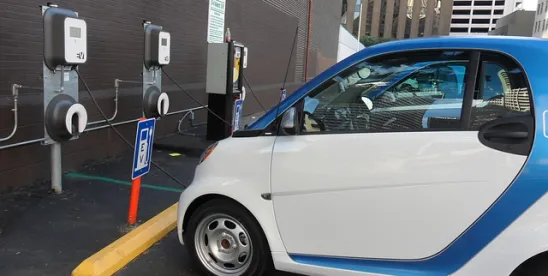On June 20, 2018, the Multi-State Zero Emission Vehicle (ZEV) Task Force released an Action Plan designed to accelerate the adoption of electric vehicles in the United States. The Action Plan presents 80 strategies and recommendations for states, automakers, charging and fueling infrastructure companies, utilities, and other partners to achieve rapid ZEV market growth in five core areas:
- consumer education and outreach;
- charging and hydrogen fueling infrastructure;
- consumer purchase incentives;
- light-duty fleets; and
- dealerships
The Action Plan’s recommendations reflect transportation-focused efforts to combat climate change for the future. By promoting the adoption by mainstream consumers of ZEVs, which include plug-in hybrid, battery electric, and hydrogen fuel cell vehicles, the goal is to achieve “near-and long-term” greenhouse gas (GHG) reduction targets that have been implemented in various states.
I. Background
The Multi-State ZEV Task Force includes nine states—California, Connecticut, Maryland, Massachusetts, New York, Oregon, Rhode Island, Vermont, and New Jersey that collectively comprise one-third of the U.S. vehicle market. The Task Force was formed in 2013 under a Memorandum of Understanding (MOU) signed by the Governors of California and the initial seven states that adopted California’s ZEV regulations, which are more stringent than the federal vehicle emission standards. New Jersey joined the Task Force in 2018.
The Multi-state ZEV Task Force released its first Action Plan in May 2014 to support the implementation of the states’ new ZEV regulations. The 2014 Action Plan focused on eleven key initiatives, including adopting financial incentives and education programs that have been implemented by various states.
II. The New Action Plan
The new Action Plan builds on the early successes of the 2014 Action Plan by “redoubling state efforts” and “establishing clear priorities for action for the next critical period in the evolution of the market.” Promoting transportation electrification promises to deliver “substantial energy security and economic benefits as cleaner electricity derived from renewable energy and other low-carbon sources replaces imported gasoline and diesel as transportation fuels.”
Among the 80 ideas, key recommendations from the five priority areas include the following:
Consumer Education and Outreach
- States should support local grass roots efforts to increase consumer experience with ZEVs, such as ride and drives, rental programs, and pop-up ZEV show rooms.
- Automakers and dealers should increase brand-specific advertising as new ZEV models become available and fund brand-neutral consumer awareness campaigns, such as Drive Change. Drive Electric.
- Utilities should include funding for consumer education in transportation electrification program proposals submitted to public utility commissions (PUCs).
Charging and Hydrogen Fueling Infrastructure
- States should develop plans to guide the deployment of electric vehicle supply equipment (EVSE) to support the broad portfolio of charging needs at home, work, around town, at destination locations, and on the road.
- States should open PUC proceedings to consider alternative demand charge rate designs, waivers or other options for public charging to provide the least burdensome price signals to EVSE hosts.
Consumer Purchase Incentives
- States should collaborate with automobile manufacturers, dealers, utilities, other parties to advocate for the continued availability of federal tax credits.
- States should continue to offer and promote existing state rebates, income tax credits, and sales and excise tax exemptions.
- Automakers and dealers should continue to engage with state and local ZEV and EVSE incentive programs regarding monetary and non monetary incentives such as preferential parking, discounted tolls, and High Occupancy Vehicle lane access.
Light-Duty Fleets
- States should advance the electrification of public fleets by offering financial incentives to state and local government fleets for acquisition of ZEVs and EVSE.
- Fleet Manager Associations should provide information and guidance to members about the benefits of ZEVs and charging/fueling technologies and costs through ZEV-focused information sessions and trainings.
Dealerships
- States should highlight dealerships with successful ZEV practices and engage with dealers through the Task Force Dealership Workgroup to identify collaboration opportunities that could support sales.
- Dealerships and dealership associations should commit to increasing ZEV sales by identifying and adopting best practices to overcome the challenges of selling ZEVs to new consumers.
The full Multi-State Zev Action Plan is provided here.
Toks Arowojolu contributed to this article.



 />i
/>i
